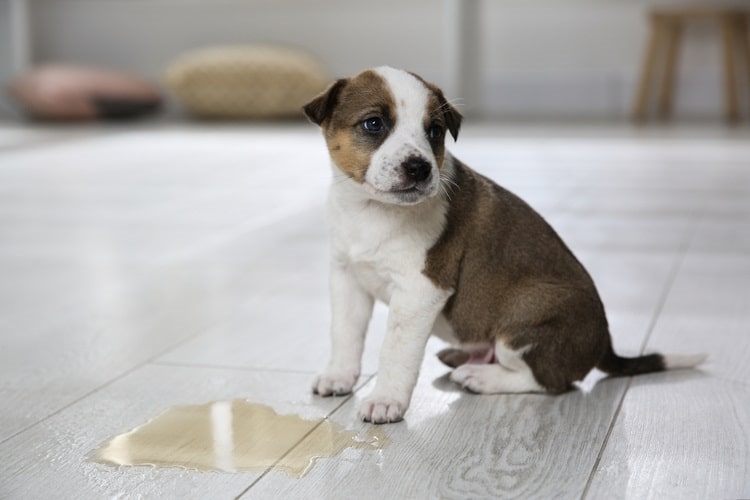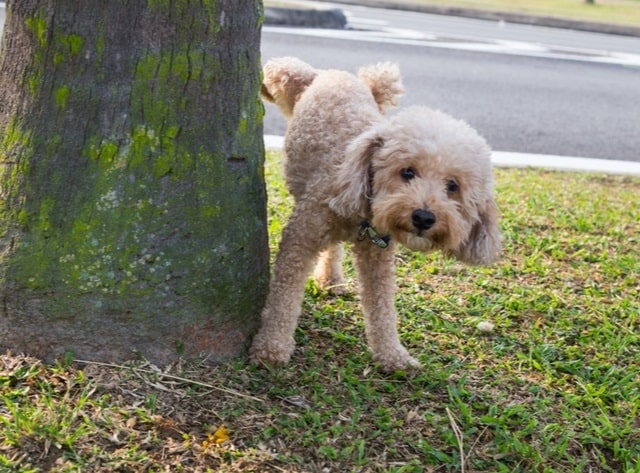Adopting a new puppy or even an adult dog is a very exciting time. Multiple studies have shown that owning a canine companion is beneficial for our health and well-being.1 While your new dog surely brings joy and companionship, tasks like training your dog to stay out of a room, keeping your dog out of the trash, and certainly training your dog to the potty-training phase can be stressful and confusing for some dog owners. To set your dog up for success, approach training by thinking about things from your dog’s perspective. If you are feeling overwhelmed by the thought of getting your dog to pee outside, read on to find out the best tips and tricks for potty-training a dog of any age.
1. Create a Routine
It’s no secret that humans benefit from having a routine, so it’s no surprise that our furry family members also benefit from having structure.2 Establish a daily routine for your dog by taking them outside to potty at the same times every day. You should take your dog outside immediately after they wake up and before bed. For puppies, it is important to remember that their bladders are smaller, and they will need to go outside frequently. A good rule of thumb is that a puppy can control its bladder one hour for every month of age. For example, a 3-month-old puppy can hold its bladder for roughly 3 hours. If you wait longer than this timeframe to take your dog outside, you run the risk of them having an accident. Other important times to take your puppy outside to potty are during and after playing and shortly after eating or drinking.
2. Use Commands
We know that dogs can be trained to listen to commands, like “sit” and “stay.” Potty-training commands should be utilized in the same fashion.3 When you take your puppy outside, take them to a designated bathroom spot, such as an outdoor dog kennel, and use a simple command like “Go Potty” or “Go Pee” right when they are about to go. This will allow your dog to correlate a verbal command to the desired behavior of going potty outside.
3. Give Positive Reinforcement Immediately. Avoid Punishment.
Your dog’s brain has a reward system, just like humans!4 When training your dog to potty outside, you should use positive reinforcement so they will repeat the desired behavior.5 Take your dog to the designated bathroom spot, such as in an outdoor dog kennel, and tell them to “go potty.”
When they do their business, immediately give them lots of verbal praise (such as “yes,” “good boy/girl”, etc.) and a treat reward. Choose a high-value treat and give the reward immediately after your dog goes potty.6 Use something special, like freeze-dried liver treats, that your dog receives only for going potty outside. Most dog trainers agree that you must reward your dog in under 2 seconds of the desired behavior in order for them to associate the behavior with the reward.7
Although it may be tempting to punish your dog if they have an accident inside, it is unlikely to be of any benefit unless you directly catch them in the act. Remember that punishment only tells your dog what not to do and does not help them learn the desired behavior. Check out these animal behaviorists’ reasons on why punishment should be avoided. If you do happen to catch your dog having an accident inside, distract (but not scare) them with a “no” or other noise and immediately take them outside. Remember to give a high-value reward immediately after they go potty outside. Using this method, you are correcting the unwanted behavior by distracting them and then communicating the desired behavior by giving a reward for it.
4. Consider Crate Training
Part of training a dog to potty outside is to ensure that your dog is always supervised. If you do need to leave your dog unattended, crate training is the best way to prevent accidents indoors. There are numerous benefits of crate training your dog, the biggest one being that dogs don’t like to go potty where they sleep.8 By confining your dog when you’re away from the house or even at night, they will learn to hold their bladder while in their crate. Learn some tips on crate training your dog here.
5. Have Reasonable Expectations
When training a dog to pee outside, you should expect that accidents are sometimes going to happen. After all, that’s why we call it training! We know that human babies require time and patience to learn how to use a toilet, and it’s not much different for our four-legged companions. It is our responsibility to set our dogs up for success by establishing a routine, using commands, utilizing crate training, and positively reinforcing the desired behavior.
6. Accidents Happen – Here’s How to Handle Them
Accidents are a normal and expected part of the potty-training process. Remember to not punish your dog unless you catch them in the act or within 2 seconds of having an accident. Keeping a clean indoor environment for your dog is a key component of potty-training. A dog’s sense of smell is far more powerful than humans, so it’s crucial to clean up accidents thoroughly to remove that smell from their environment. Otherwise, they will continue to smell the urine and may think that area is their bathroom! This is particularly problematic if your dog is peeing in the bed. The best products for cleaning up accidents are enzymatic cleaners specifically for urinary accidents. Nature’s Miracle foaming cleanser makes clean-up a breeze, whether cleaning carpet or hard floors.
One way to help lower the impact of accidents is to address it with the type of bed you use, specifically by choosing a waterproof washable dog bed, the best elevated dog bed you can find that’s also waterproof, a waterproof outdoor dog bed for winter, or even a dog bed for a couch with a washable liner.
7. Be Cautious About Using Pee Pads
When your dog is unsupervised and you’re worried about them having an accident, you may be tempted to put down a pee pad to make clean-up easy. Now think about the message this is sending to your dog. Your dog will think that going potty inside is okay and this is going to complicate training your dog to perform the desired behavior of going potty outside. Aside from sending mixed messages, there are several other reasons why pee pads aren’t a great idea when potty-training your dog.9
If you’re also struggling with training your dog in other areas (like keeping your dog out of a room or keeping your dog out of the trash) then you might want to check out our list of the best dog proof kitchen trash cans.
Article Sources
Pet News Daily uses only high-quality sources, including peer-reviewed studies, to support the facts within our articles. Read our editorial process to learn more about how we fact-check and keep our content accurate, reliable, and trustworthy.
- Medical News Today. Dogs: Our best friends in sickness and in health. Medicalnewstoday.com. Accessed December 1, 2021.
- Northwestern Memorial. Health Benefits of Having a Routine. Nm.org. Accessed December 1, 2021.
- Correal L. Why Dogs Understand Commands. Wagwalking.com. Published March 7, 2018. Updated January 30, 2020. Accessed December 1, 2021.
- Berns G, Brooks A, Spivak M. Replicability and Heterogeneity of Awake Unrestrained Canine fMRI Responses. PLoS ONE, 2013; 8 (12): e81698. doi: 10.1371/journal.pone.0081698
- The Humane Society of the United States. Positive reinforcement training. Humanesociety.org. Accessed December 1, 2021.
- Madson C. What Kind of Treats Should You Use to Train Your Dog. Preventivevet.com. Published February 10, 2020. Updated September 30, 2021. Accessed December 1, 2021.
- Dobkins N. The 5 Pillars of Dog Training – Pillar #1: Timing. Workingdogmagazine.com. Published February 17, 2020. Accessed December 1, 2021.
- Arford K. Crate Training Benefits: Why A Crate Is Great for You and Your Dog. Akc.org. Published November 19, 2019. Accessed December 1, 2021.
- PetHelpful. Say No-No to Wee-Wee Pads (How to Potty Train Your Puppy the Right Way). Pethelpful.com. Published April 12, 2021. Accessed December 1, 2021.


